The world of digital advertising and marketing is constantly evolving, and staying ahead means embracing the latest tools and technologies. Google Analytics 4 (GA4) represents a significant leap forward, offering new capabilities and insights crucial for data-driven decision-making. Today we will explore the features of GA4 and how they can be leveraged alongside Google Tag Manager (GTM) for enhanced marketing strategies.
Key Features of GA4 and Their Benefits
GA4 isn't just an upgrade; it's a reimagining of analytics for the modern web. The transition from Universal Analytics to GA4 marks a pivotal change in how data is collected, processed, and utilized. This section explores the reasons behind this shift and what it means for businesses.
Learn about all of the new features of GA4
Unified Measurement Across Platforms
GA4's ability to measure user interactions across web and mobile provides a holistic view of customer behavior. This unified approach is crucial for businesses looking to understand and engage their audience effectively across multiple touchpoints.
Understanding Customer Journeys Across Devices
Cross-Device Tracking: GA4's advanced cross-device tracking capabilities allow businesses to follow the customer journey across different platforms. Whether a user starts their journey on a mobile app and completes a purchase on the web, or vice versa, GA4 captures this journey, providing valuable insights into user behavior and preferences.
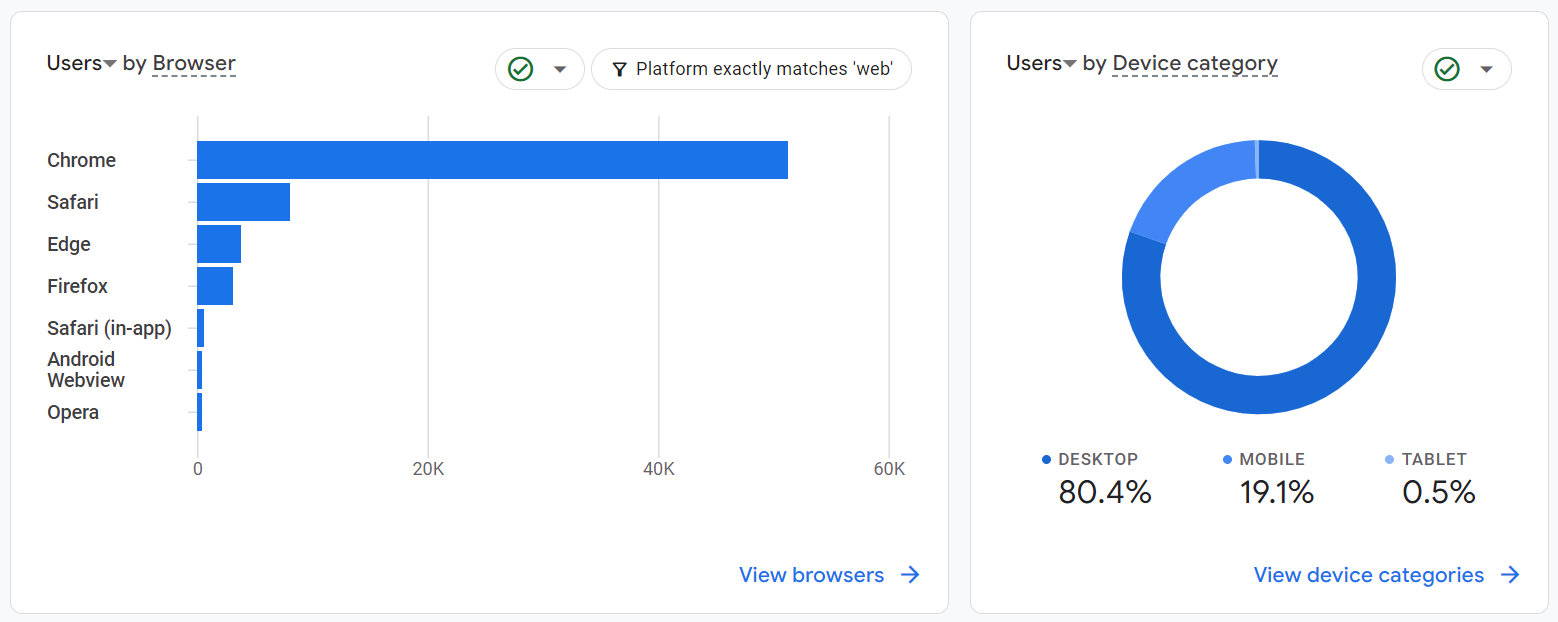
User-Centric Analysis: Unlike traditional analytics that focuses on sessions or page views, GA4 emphasizes user-centric analysis. This approach provides a more accurate and holistic view of how users interact with a brand across different devices, leading to more informed marketing and engagement strategies.
Enhanced Reporting and Insights
Consolidated Reporting: With GA4, businesses no longer need to juggle between separate reports for web and mobile analytics. GA4 consolidates data from both platforms into a single, comprehensive report, making it easier to analyze overall performance and identify trends.
Customizable Dashboards: GA4 allows the creation of customizable dashboards that can display key metrics from both web and mobile platforms. This feature enables businesses to focus on the metrics that matter most to them, ensuring quick access to relevant data.
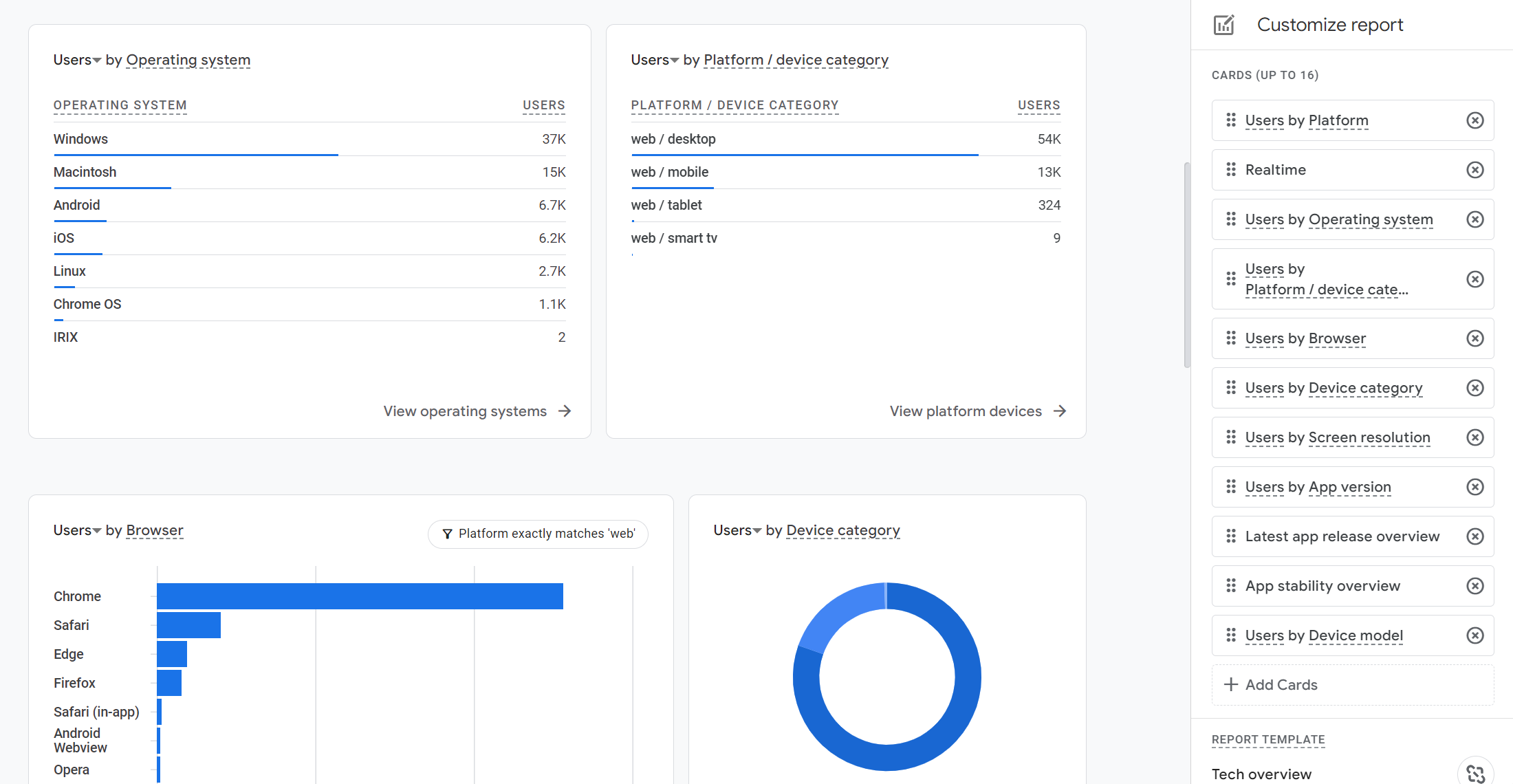
Leveraging Data for Targeted Marketing
Segmentation and Targeting: By understanding user behavior across platforms, businesses can create more targeted marketing campaigns. GA4 helps in segmenting audiences based on their interactions, whether on mobile apps or websites, enabling more personalized and effective marketing efforts.
Predictive Analytics: GA4's predictive analytics capabilities use data to forecast future user behaviors. This feature is invaluable for businesses looking to anticipate customer needs and tailor their strategies accordingly.
User-Level Identification with Cookie-less Tracking
GA4's approach to user-level tracking without relying on cookies is a game-changer. It aligns with modern privacy standards and provides more accurate insights into user behavior while maintaining user privacy.
Understanding Cookie-less Tracking in GA4
The Shift from Cookies: GA4's departure from traditional cookie-based tracking marks a significant evolution in web analytics. Unlike its predecessors, GA4 utilizes advanced algorithms to gather user data, bypassing the need for cookies. This method not only adheres to the increasing privacy concerns but also circumvents issues like cookie blocking and deletion, which often skew data accuracy in older systems.
Privacy Compliance: GA4's cookie-less approach is designed to be in harmony with stringent privacy regulations like the General Data Protection Regulation (GDPR) and the California Consumer Privacy Act (CCPA). By not relying on cookies, GA4 ensures that user data is collected in a manner that respects user consent and privacy, making it a future-proof solution for businesses concerned about compliance.
Enhanced User-Level Insights
Accurate User Data: The cookie-less tracking in GA4 offers a more precise understanding of user behaviors. By leveraging machine learning and non-cookie-based algorithms, GA4 can track user interactions across websites and apps more accurately, providing a clearer and more comprehensive view of user engagement and preferences.
Cross-Platform User Tracking: One of the standout features of GA4's cookie-less tracking is its ability to track users seamlessly across different platforms and devices. This capability is crucial for businesses operating in a multi-platform environment, as it allows for a unified view of the customer journey, enhancing the ability to tailor marketing strategies effectively.
Implementing Cookie-less Tracking
- Configuration: Setting up GA4 property in the Google Analytics account, ensuring that all the necessary parameters for cookie-less tracking are enabled.
- Data Streams: Establishing data streams from websites and apps to GA4, ensuring that user interactions are captured accurately.
- Testing and Validation: Regularly testing and validating the tracking setup to ensure data accuracy and integrity.
Challenges and Solutions
Adopting cookie-less tracking may present challenges such as adapting to a new data model and understanding the nuances of machine learning-driven analytics. Solutions include:
Training and Resources: Utilizing available online resources and training materials to understand GA4's new features.
Professional Assistance: Seeking assistance from analytics experts or Google-certified professionals for a smoother transition.
Contact One of Our Google Analytics Experts Today!
Event-Based Tracking in GA4
Event-based tracking in GA4 allows for a more detailed and flexible collection of user interactions. This granular data collection offers deeper insights into user behavior and preferences, enabling businesses to tailor their strategies more effectively.
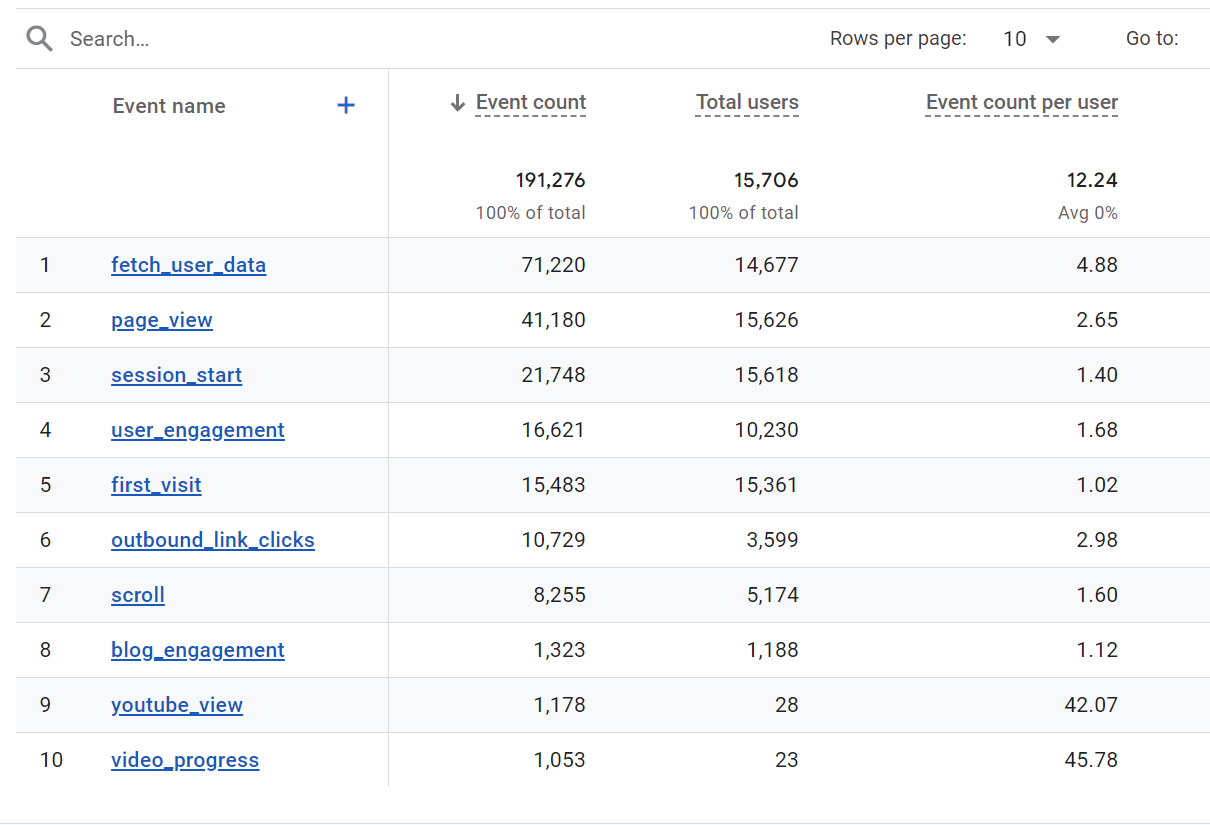
Fundamentals of Event-Based Tracking
Understanding Event-Based Tracking: As opposed to traditional pageview tracking, event-based tracking focuses on capturing specific user interactions, known as 'events', such as clicks, form submissions, or video plays. This approach provides a more holistic understanding of how users engage with a website or app.
Implementing Event-Based Tracking with Google Tag Manager and GA4
Identify Key User Interactions
The first step in implementing event-based tracking is to identify key user interactions on your website or app. These are the actions taken by users that are most significant to your business objectives. These could be
- Button clicks: Signups, downloads, social media shares, specific article links.
- Form submissions: Newsletter subscriptions, comments, contact forms.
- Video interactions: Starts, plays, completions, specific points reached.
- Scroll depth: How far users scroll down each page.
- External link clicks: Outbound traffic to specific sites.
The goal is to pinpoint interactions that provide valuable insights into user behavior and preferences, which in turn inform your marketing and product strategies.
Configuring Events in GA4
After identifying the interactions, the next step is to configure them as events in GA4. To do this, log into GA4 and navigate to the 'Events' section. Here, you'll find the option to 'Create Event'. When setting up each event, it's important to provide clear details such as the event name, category, and any additional parameters that will help in tracking and analyzing these interactions. For more complex setups, Google Tag Manager offers greater flexibility in event configuration, which we will dive into later in this section.
- Testing and Validation of Event Tracking
- After configuring your events in GA4, it's essential to rigorously test and validate that they are tracking accurately to ensure the reliability of your data. Begin by triggering each event manually on your website or app to see if they are being recorded in GA4 as expected. Look for any discrepancies or issues in data capture.
- Analyze and Utilize Event Data
- Once you have successfully set up and validated your event tracking, the next step is to analyze and utilize the data collected. Look for patterns, trends, and insights that can inform your marketing and product development strategies. This step is about translating raw data into actionable insights.
Leveraging Google Tag Manager:
While GA4 allows basic event creation, Google Tag Manager (GTM) offers superior control and flexibility. Think of it as a conductor orchestrating different instruments (tags and triggers) to achieve a harmonious symphony of data collection. Some key features include:
- Trigger-based activation: Define when events fire based on user actions, element interactions, or page elements.
- Fine-grained control: Define precisely when events fire – on specific button clicks, form submissions, page loads, element interactions, or even custom events based on JavaScript conditions.
- Targeted tracking: Focus on actions that truly matter. Don't track every click; track the ones that reveal user intent and interest (e.g., "Subscribe Now" button click instead of all menu clicks).
- Data enrichment: Add custom parameters to events, capturing valuable details like clicked button text, article titles, or form field values.
- Unleash custom parameters: Add valuable details to your events. Capture clicked button text, article titles, form field values, scroll depth, video completion percentage, and much more. This enriches your data and unlocks deeper insights.
- Dynamic values: Use variables to inject dynamic data into events. Track the specific article downloaded instead of just a generic "download" event. This personalizes the data and enables powerful segmentation.
- Multiple tracking tools: Send events not only to GA4 but also to other analytics platforms you use.
- Centralized hub: Manage tags and triggers for different analytics platforms (e.g., Facebook Pixel, Google Ads) alongside your GA4 events, all from one convenient location. No need to edit code on your website for each tool.
- Streamlined workflow: Save time and effort by avoiding code modifications for every new tracking requirement. GTM simplifies the integration and management of various analytics tools.
- Centralized management: Create and manage tags and triggers for different events from one location.
- Additional Advantages:
- Version control: Track changes made to tags and triggers, ensuring you can revert to previous versions if needed.
- Collaboration: Share access and work on event tracking collaboratively with your team.
- Testing and debugging: Utilize built-in testing and debugging tools to ensure accurate event capture before deployment.
By harnessing GTM's capabilities, you can go beyond basic event tracking and gather rich, actionable data to elevate your understanding of user behavior and optimize your blog for success. Remember, the key is to experiment, test, and refine your event tracking to continually gather valuable insights for your evolving blog and goals.
Setting Up Tags and Triggers:
1. Create a GA4 Event tag: Choose "Google Analytics: GA4 Event" tag type, enter your Measurement ID, and specify the event name (e.g., "article_download").
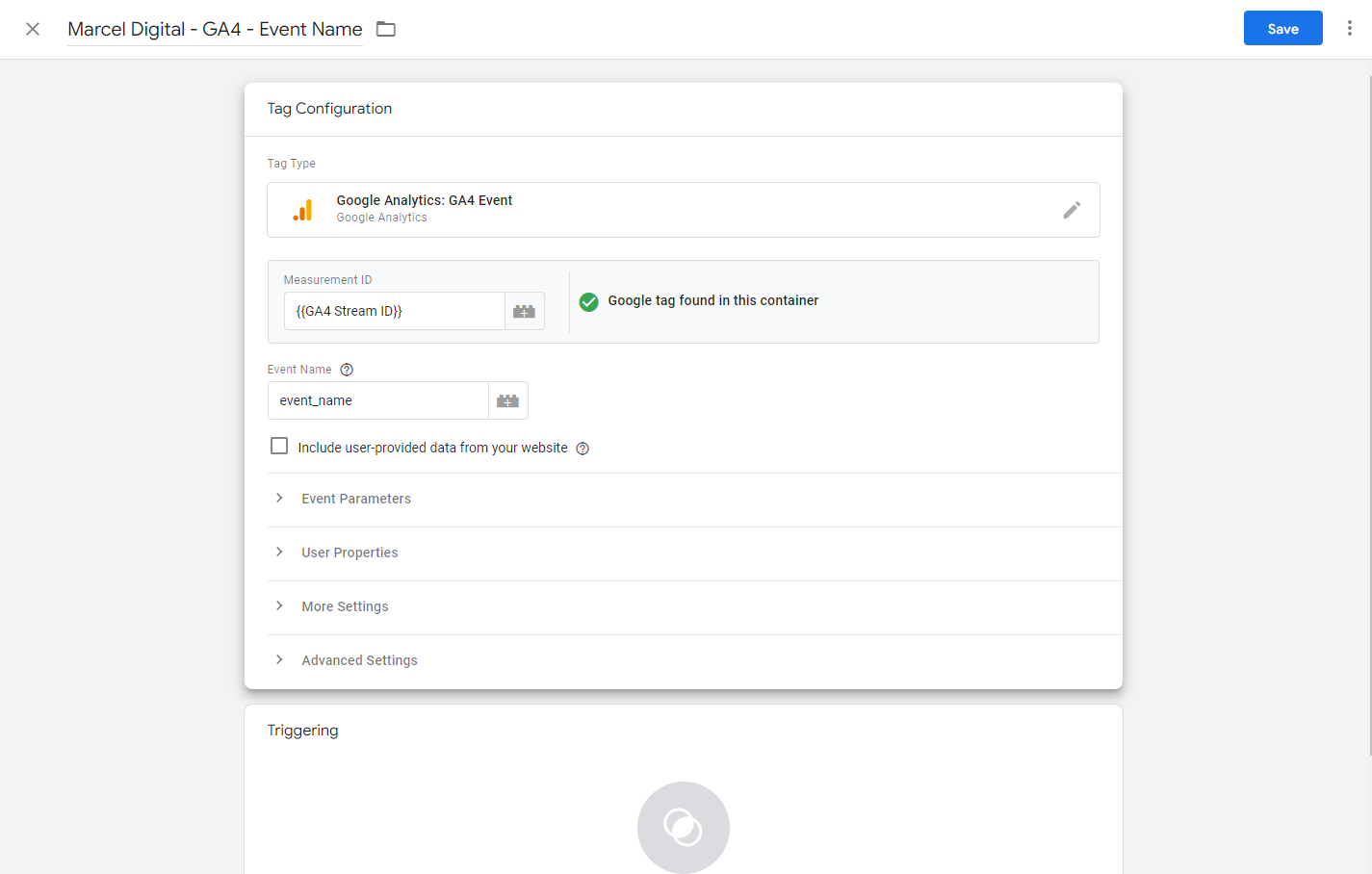
2. Build a trigger: Choose or create a trigger type based on your desired event (e.g., "Click: All Elements" for button clicks).
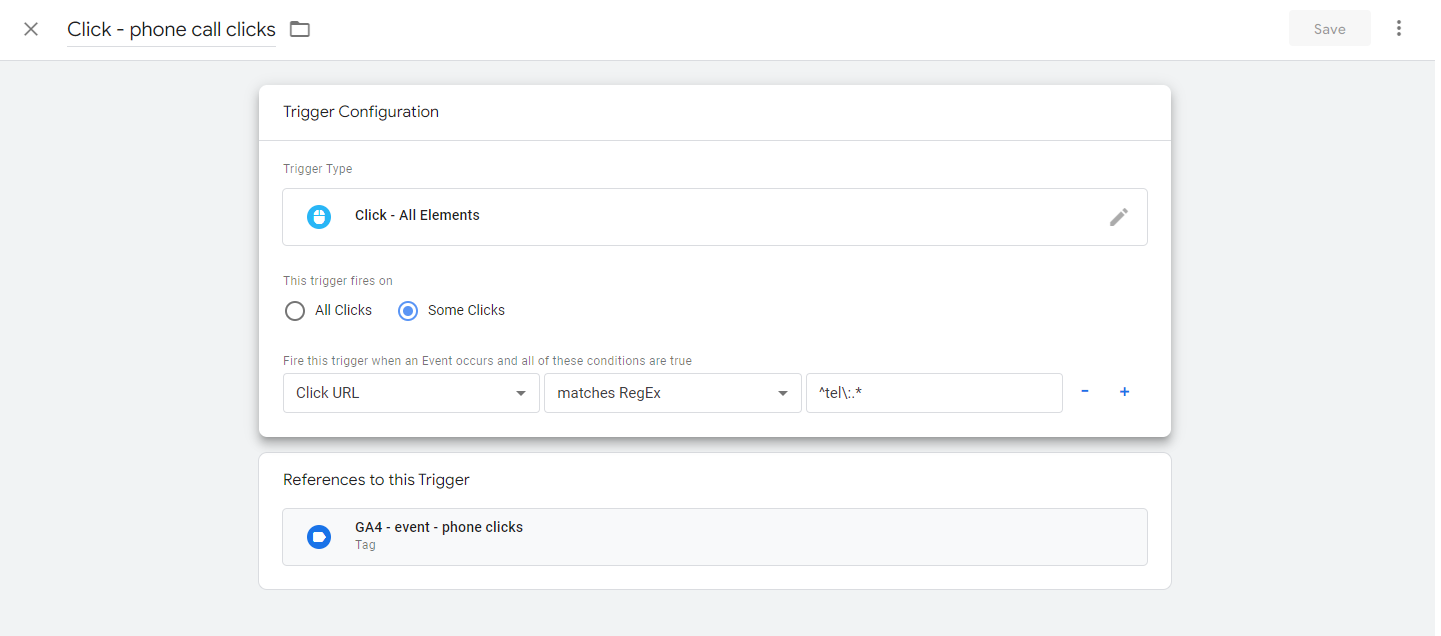
3. Link tag and trigger: Connect your GA4 Event tag to the relevant trigger. When the trigger fires (e.g., button click), the tag sends the event with its details to GA4.
Testing and Validation:
- Preview mode: Use GTM's preview mode to simulate user actions and verify event firing in real time.
- DebugView: Inspect captured data details for accuracy and completeness.
- GA4 Real-time reports: After publishing in GTM, give GA4 up to 24 hours to register the newly created event and begin collecting data and you will be able to view events as they happen in GA4 to confirm successful tracking.
Advanced Tracking Opportunities:
- Dynamic event values: In preview mode use the variables section to capture and understand dynamic data, like clicked element IDs or form field values, for richer insights.
- Custom dimensions: Define custom dimensions in GA4 to categorize events further (e.g., article category, author name).
- Enhanced measurement: Implement advanced tracking features like scroll tracking or video engagement measurement.
Analyze and Utilize Event Data:
- Explore GA4 reports: Analyze event data within user engagement, conversions, and custom reports.
- Identify trends and patterns: Look for insights into user behavior, content performance, and areas for improvement.
- Actionable intelligence: Use data to inform content strategy, marketing campaigns, and website optimization efforts.
Best Practices When Using GTM:
- Clear naming: Use descriptive names for tags, triggers, and events for easier management and understanding.
- Documentation: When submitting and publishing your updated document your changes and setup for future reference and maintenance.
- Continuous improvement: Regularly review and refine your event tracking as your goals evolve, and business expands.
By leveraging GTM and GA4 for event tracking, you gain detailed insights into user behavior, enabling data-driven decisions. Next, we'll explore Data-Driven Attribution (DDA), where machine learning helps you analyze users' pathways to conversion, ensuring every channel plays its part and gets credit in driving conversions.
Data-Driven Attribution (DDA)
GA4's Data-Driven Attribution model uses advanced machine learning to better understand how different marketing channels contribute to conversions. This insight is invaluable for optimizing marketing spend and strategy.
Advanced Insights into Marketing Channel Efficacy
GA4's Data-Driven Attribution (DDA) model represents a significant leap forward in understanding the impact of various marketing channels on customer conversions. By leveraging advanced machine learning algorithms, DDA in GA4 goes beyond traditional attribution models to offer a more nuanced and accurate picture of how each channel contributes to the user's journey toward conversion.
Understanding the Customer Journey
Traditional attribution models often oversimplify the customer journey by giving undue credit to the last click or first click. However, DDA in GA4 recognizes that the path to conversion is rarely linear. It considers the entire journey, including all touchpoints a customer interacts with, before deciding. This comprehensive view allows marketers to understand the true value of each channel, whether it be social media, email marketing, paid search, or organic search.
Optimizing Marketing Spend
With a clearer understanding of which channels are most effective, businesses can allocate their marketing budget more efficiently. DDA helps identify underperforming channels and highlights opportunities where additional investment could yield higher returns. This level of insight is crucial for maximizing ROI and ensuring that marketing efforts are not just driving traffic, but contributing to tangible business outcomes.
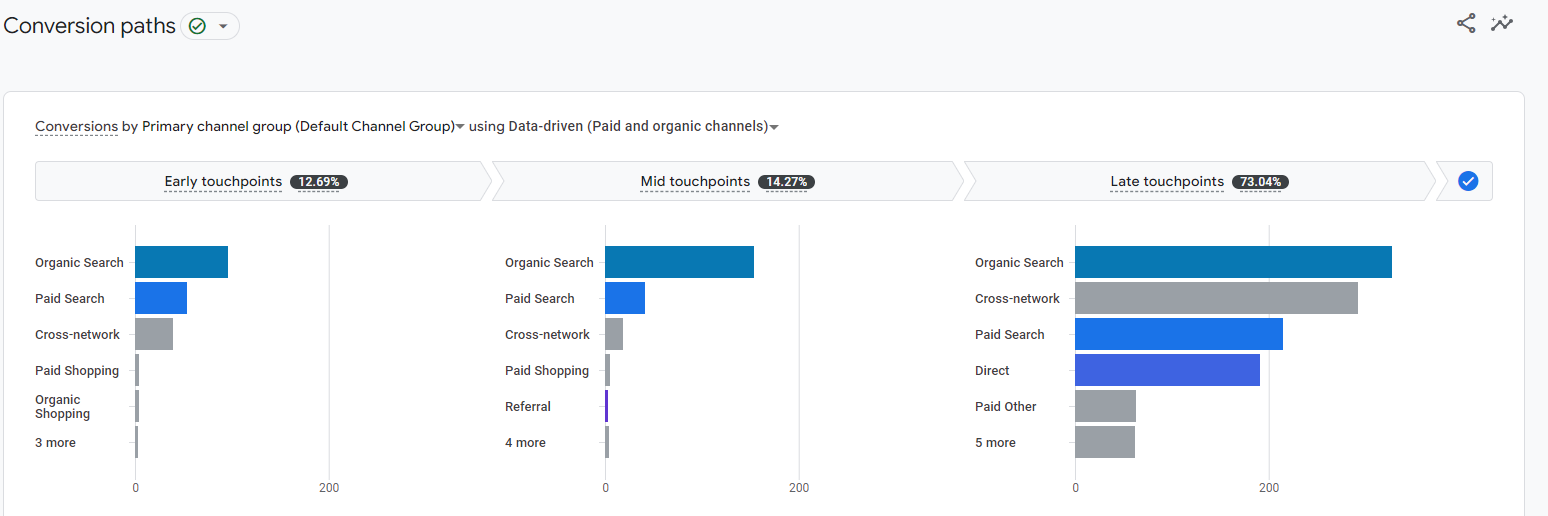
Maximizing GA4's Potential with Marcel Digital's Expertise
Marcel Digital specializes in creating customized analytics solutions that align with your business objectives. By leveraging GA4 and GTM’s advanced capabilities, we can help you understand your audience better, track user behavior more accurately, and optimize your marketing strategies effectively.
Contact Marcel Digital today to explore how we can elevate your data-driven strategies with Google Analytics 4.
Do you trust your data?
Turn uncertainty into insight. Our Data Maturity Assessment gives you a personalized report with your strengths, gaps, and next steps.

Analytics
About the author
Dan Kipp
Dan Kipp is the Google Analytics and Google Tag Manager guru at Marcel Digital. He loves traveling, cooking, sports, and spending spare time with friends and family.